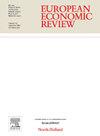小型开放经济体的财富收入比:荷兰,1854-2019
IF 2.4
2区 经济学
Q1 ECONOMICS
引用次数: 0
摘要
我们构建并分析了荷兰自1854年以来的家庭财富及其构成。在20世纪,家庭财富收入比遵循了我们熟悉的u型模式。在工业化和蓬勃发展的私人外国投资的推动下,财富收入比在19世纪上升,在1880年左右达到700%的峰值。与其他国家相比,美国的财富收入比直到1929年仍然很高。我们构建了文献中关于殖民地财富的第一个系列,并表明殖民地和其他外国投资占了二战前与其他国家差距的大部分。战后该比率的最初下降是由收入的快速增长推动的。自20世纪70年代以来,这一比率的上升主要是由大型资本资助的养老金制度推动的。由于大量的抵押贷款债务,住房在净财富积累中只起次要作用。本文章由计算机程序翻译,如有差异,请以英文原文为准。
Wealth-income ratios in a small, open economy: The Netherlands, 1854–2019
We construct and analyze household wealth and its composition for The Netherlands since 1854. The household wealth-income ratio followed the familiar U-shaped pattern over the 20th century. The wealth-income ratio increased in the 19th century, driven by industrialization and booming private foreign investments, to a peak of 700% around 1880. In contrast to other countries, the wealth-income ratio remained high up until 1929. We construct the first series on colonial wealth in the literature and show that colonial and other foreign investment account for most of the gap with other countries in the pre-WWII period. The initial post-war decline of the ratio is driven by rapid income growth. The increase in the ratio since the 1970s has been mainly driven by the large capital-funded pension system. Housing plays only a secondary role in net wealth accumulation due to significant mortgage debt.
求助全文
通过发布文献求助,成功后即可免费获取论文全文。
去求助
来源期刊

European Economic Review
ECONOMICS-
CiteScore
4.70
自引率
3.60%
发文量
170
期刊介绍:
The European Economic Review (EER) started publishing in 1969 as the first research journal specifically aiming to contribute to the development and application of economics as a science in Europe. As a broad-based professional and international journal, the EER welcomes submissions of applied and theoretical research papers in all fields of economics. The aim of the EER is to contribute to the development of the science of economics and its applications, as well as to improve communication between academic researchers, teachers and policy makers across the European continent and beyond.
 求助内容:
求助内容: 应助结果提醒方式:
应助结果提醒方式:


